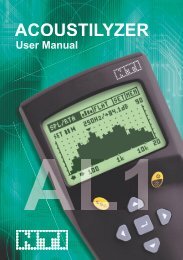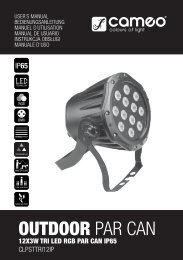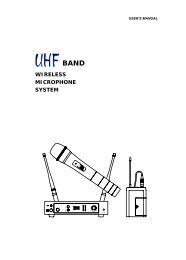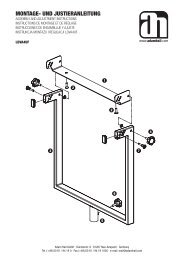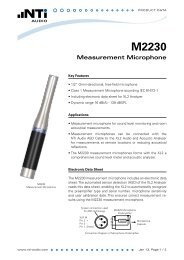Speech Intelligibility - Elma Instruments
Speech Intelligibility - Elma Instruments
Speech Intelligibility - Elma Instruments
Create successful ePaper yourself
Turn your PDF publications into a flip-book with our unique Google optimized e-Paper software.
STI-PA Measurement Hints<br />
APPlicAtion note<br />
• Any background noise has to be sufficiently static during the<br />
measurement, e.g. pink noise fulfills this requirement.<br />
• Verify the environmental conditions prior testing. Complete<br />
STI-PA measurements without any test signal. The results shall<br />
be < 0.20 STI.<br />
• Impulsive background noise during the measurement, such as<br />
speech, cause severe measurement errors. The STI-PA result<br />
is usually too high.<br />
• In case such an impulsive noise cannot be prevented, the measurements<br />
might be shifted e.g. to night time, and afterwards<br />
corrected with the averaged daily background noise, using<br />
external post processing.<br />
• Any CD-Players used to reproduce the STI-PA test signal have<br />
to be accurate as only limited time-shifts (+/- 200 ppm) are<br />
allowed to ensure reliable STI-PA test results. Pitch control<br />
and shock protection shall be disabled. Thus only professional<br />
players shall be used. You may verify the time shift of your CD-<br />
Player with a 1 kHz test signal:<br />
• Insert the NTi Audio Test CD into the CD player and start track<br />
1, which is the 1 kHz test signal.<br />
• Connect the XL2 directly to the audio output and measure the<br />
signal frequency in the RMS/THD mode. The displayed frequency<br />
shall be in the range from 0.9998 kHz to 1.0002 kHz<br />
• STI-PA test signals of other test system manufacturers may<br />
sound similar but are not compatible. Only the NTi Audio STI-<br />
PA test signal CD V1.1 or higher shall be used in combination<br />
with the XL2.<br />
• STI-PA measurement of alarm systems should be carried out<br />
at emergency conditions (same sound pressure level and all<br />
components are activated).<br />
• At locations with varying conditions e.g. some public areas<br />
with few people; others with crowds -- the worst case STI-PA<br />
results should be measured. Consult your local regulations<br />
(e.g. in the U.S., the NFPA code) for specific directives concerning<br />
measurement locations and number of required total<br />
STI-PA measurements under different circumstances.<br />
• Select typical locations based upon such regulations, or typically<br />
position the microphone at 1 - 1.2 meters above ground<br />
in sitting areas or 1.5 - 1.8 meters in standing areas (typical<br />
measurement positions are normally not directly in front of the<br />
speakers).<br />
www.nti-audio.com Page 12 / 14



